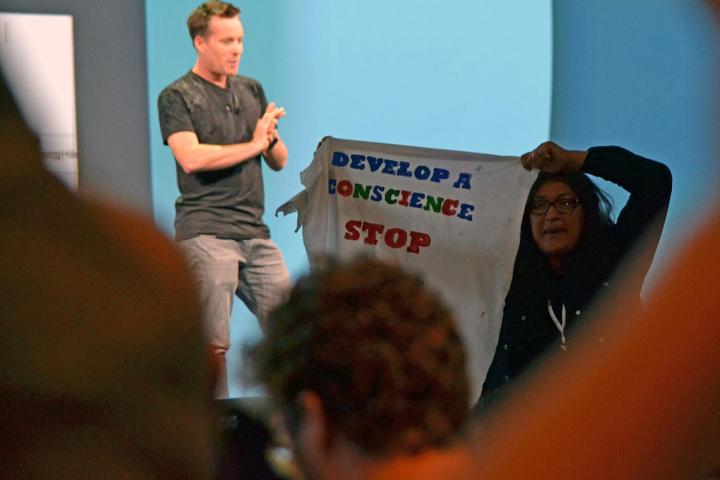
Google protesters made their presence known before and during Google’s developer conference, which takes place at its headquarters in Mountain View, California.
Starting on Tuesday, Occupy Google supporters showed up on Google’s campus with signs that show the group’s pro-net neutrality emotions:
Net Neutrality supporters #occupy #Google Headquarters! #osf #oo #ows #occupygoogle #WeOutHere pic.twitter.com/NRzM1jyDJW
— Occupy Google (@occupygoogl) June 24, 2014
As Tuesday night rolled around, Google called in the police. Though they seemed quite lax, according to Occupy Google’s Twitter feed, officers began asking demonstrators to leave. Police said that if they failed to do so, they would be arrested for trespassing:
This one threatening arrests pic.twitter.com/m0dQYkozaV
— Occupy Google (@occupygoogl) June 25, 2014
According to the Mountain View Police Department, 10 protesters were arrested. While the department confirmed Google was “supportive” of the protests, the search giant wasn’t supportive of the protests overnight, beginning at 9pm local time.
Based on the police’s account, demonstrators were told to leave, but that they could come back in the morning. Two demonstrators sat down and refused to leave, which led to their arrest. Several others remained in the area, with Google subsequently signed a Private Person’s Arrests for Trespassing, with all 10 having been arrested “without incident.”
Broadcast live streaming video on Ustream
Protests, however, didn’t stop there. During Google I/O, a demonstrator shouted evictions allegedly caused by a Google employee.
Ruh roh. Protestor at @Google I/O pic.twitter.com/MeHOAunfkE
— Joseph (@jrvolpe) June 25, 2014
The unnamed protester held up a t-shirt that read “develop a conscience, stop Jack Halprin.” Halprin, a Google attorney, was the subject of an April protest that had protesters assemble outside his seven-unit home. They accused him of evicting all other six tenants from the property, with at least two of the evicted tenants saying they were San Francisco teachers, based on a report by SF Examiner.
Roughly an hour later, another protester made his voice known. He shouted out, “Don’t work for a totalitarian company that builds robots that kill people!” He also said “you know that’s true” before being escorted out of the area.
Protesters and Google have been butting heads for a number of years. Back in 2008, a group of Japanese lawyers and professors protested Google’s Street View functionality. More recently, protesters criticized Google’s private bus program, which employees use to go to Google’s headquarters in Mountain View. Protesters blocked two buses ferrying Google and Apple employees to work, arguing that the buses were a metaphor for the increasing wealth gap protesters blame on Google and Apple, among others.
The protesters purport that the wealth created by these firms fail to trickle down to the local community, pushing property prices sky high and generally having an adverse effect on the area.
With Google and Apple further expanding their work spaces, it’s likely that more protests will continue to surface.
Editors' Recommendations
- The 6 biggest announcements we expect from Google I/O 2024
- iOS 18 could make my iPhone look like Android, and I hate it
- Google Pixel Fold 2: news, rumored price, release date, and more
- We finally know the exact date of Google I/O 2024
- How to stop spam texts on iPhone and Android phones


